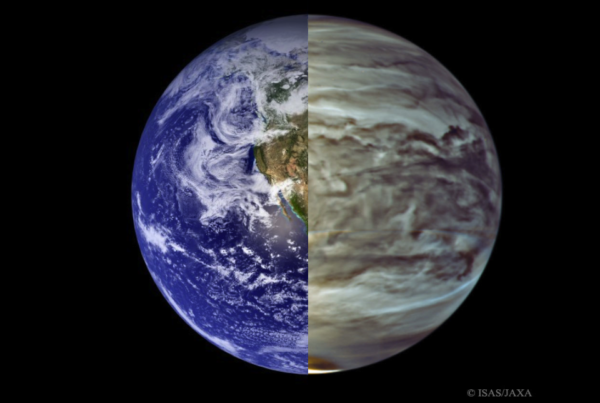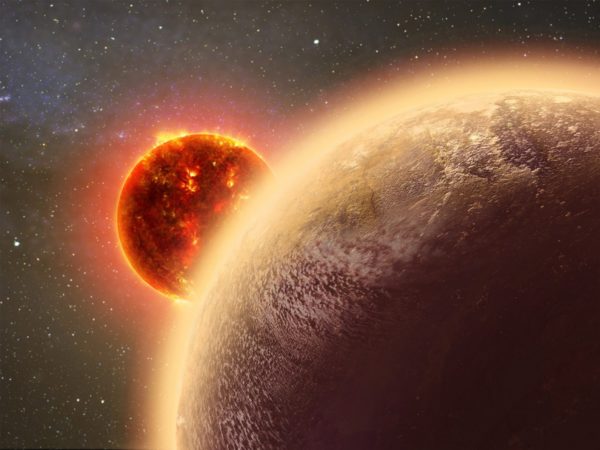"To consider the Earth as the only populated world in infinite space is as absurd as to assert that in an entire field sown with millet, only one grain will grow." -Metrodorus of Chios
Later tonight, the European Southern Observatory is expected to make an announcement, and the smart money is on the discovery of an Earth-like planet orbiting Proxima Centauri, the nearest star to our Sun. As incredibly exciting as this news is, however, it’s important to keep in mind that “Earth-like,” to an astronomer, means something very different than what we think of as “actually like Earth.”
 The Earth (L) in visible light, compared with Venus (R) in infrared light. While Earth’s reflectivity will vary over time, Venus’ will remain constant. Image credit: NASA/MODIS (L), ISIS/JAXA (R), stitching by E. Siegel.
The Earth (L) in visible light, compared with Venus (R) in infrared light. While Earth’s reflectivity will vary over time, Venus’ will remain constant. Image credit: NASA/MODIS (L), ISIS/JAXA (R), stitching by E. Siegel.
The only information we can glean from our present observations is the planet’s mass, size and orbit around a star. This is enough to tell us some of its properties, including a few ways (like tidal locking) that are quite different from Earth, but questions about its atmosphere, surface temperature, magnetic field and much more remain unanswered.
 An illustration of a panet around a red dwarf star. Only gas giant worlds are large enough to have their atmospheres detected at this point in time. Image credit: ESO.
An illustration of a panet around a red dwarf star. Only gas giant worlds are large enough to have their atmospheres detected at this point in time. Image credit: ESO.
Come learn what the discovery of a new planet around our closest star would and wouldn’t tell us!
- Log in to post comments

My understanding of this area is limited, but I think a caveat is in order. Mass, size, and distance can tell us whether a planet must be tidally locked or not, but the planets calculated as 'not necessarily locked' could be locked anyway.
AIUI this is basically the case for Venus; if you do the calculation for our sun and planets, only Mercury would be calculated to be locked; Venus would be calculated to be not locked. And indeed, technically, Venus is not entirely locked. However its day (243 days) is about the same as its year (225 days), so it is for practical purposes, pretty close to being locked.
So if we find a planet around Proxima Centauri of the right mass, distance, etc., and our calculations also tell us it is not necessarily tidally locked, it could still by historical contingencies have a day-length close to its orbital period. At leas, AIUI.
TL:DR version: we can tell when some celestial body definitely is locked, but we can't tell when it definitely isn't.
@Ethan wrote
Being that Proxima Centauri's potential planet is being detected the radial velocity method instead of the transit method, I don't believe we do get radius data. There is also no chance of detecting atmosphere because the atmosphere is never between us and the star.
Until we can get a giant telescope capable of direct imaging this planet, I'm not sure we'll know much about it unless we're lucking enough for that system to be oriented perpendicular to us.
Planets with magnetic fields emit powerful auroral radio emissions from their poles when hit by coronal mass ejections. In this, magnetically shielded planets are actually "brighter" than their host star, but we'll still need the pole to be aimed at us to detect it.
From the BBC:
They also show a graphic of star sizes to provide some context. Don't know if their graphic is accurate or not, but on it, Proxima Centauri is just a bit bigger than Jupiter.
Oops, sorry, forgot to include the link
As an aside, I am dismayed that the BBC actually emitted the construction "40 trillion km away." Putting aside the issue of the milliard, the unit is text, knuckleheads. And I don't believe for a second* that it's applied uniformly.
* Koff.
“… the European Southern Observatory is expected to make an announcement, and the *smart money* is on the discovery of an Earth-like planet orbiting Proxima Centauri…”
The even smarter money is on it having no life.
G-d made mirrors for a reason, dear.
NASA's Pic of the Day commenter states that the planet is close enough for two way communication. What, an 8 and a 1/2 year wait for a reply? An 11 day year would be enough to deal with (not) !
"Being that Proxima Centauri’s potential planet is being detected the radial velocity method instead of the transit method, I don’t believe we do get radius data."
The orbital velocity of a planet around a star is given by the square root of G times the mass of the star divided by the radius, and if the mass of the star is known (it is), you get the radius from radial velocity.
@Wow #9: Denier #2 was talking about the radius of the planet, not of the star. The radius of Proxima Centauri itself is known from direct observation (it is close enough to image the disk), and is about 0.14 R_Sun.
The radial velocity (RV) method _does_ get you the orbial radius, which is what you described.
The radius of the planet has been guessed by taking the planetary mass extracted from the RV fit, and assuming a rocky-planet (Earth) density.
@Wow #9
The 'r' in that formula is the radius of the orbit not the radius of the planet and it only works for perfectly circular orbits. If the orbit is the tiniest bit eccentric, as all real planetary orbits are, your formula doesn't work. Even in the best case your formula doesn't give you what you think it does, and in reality is really, really, really doesn't give you what you think it does.
Crud. Kelsey beat me to it.
"@Wow #9: Denier #2 was talking about the radius of the planet, not of the star"
Ah, makes more sense. But why would a planet be relevant there?
Mind you, you CAN get some radius information from the doppler shift of the stellar limb, the problem being discerning the effect from the messy signal of the atmosphere that isn't on the limb.
But again, I would have no idea why an earth like planet should come up with the radius of the parent star....
"The ‘r’ in that formula is the radius of the orbit not the radius of the planet and it only works for perfectly circular orbits."
And by perfect, that means an orbital eccentricity close to 1.
Like, oh, I don't know, LIKE EVERY PLANET AROUND OUR SUN OTHER THAN MERCURY.
I can't think why that might be an acceptable approximation...
(that should have been a different level of blockquoting).
IF denier had ASKED "How do we know the radius of the planet?" rather than implied an egregious error from Ethan, then I would not have been so confused.
I think 1.3 earth mass is a minimum mass. I think the only data is a radial velocity curve of Proxima B, we don't know the inclination of the orbit with respect to the line of sight to the earth, so we can't determine a maximum possible mass IIUC.
Solar storms/wind (dwarf-star storms) are supposed to be much stronger than what the earth feels, its not just a matter of UV radiation, its also an issue of whether the atmosphere could be retained for billions of years, or lost (like Mars). So much we don't know, and I think it will be a major challenge to get the needed data.
Also what does tidal locking do to the atmosphere? If heat transfer from the sunny side to the shadyside is too low, volatiles -including gases other than Hydrogen and Helium might be in the form of a large frozen mass on the shady side.
Far more things could go wrong as far as creating a habitable world than could go right.
In fairness, that sounds like a number of clients and vendors I have to deal with at work.
@#18
Yeah, I can relate to that, also. Sheesh !